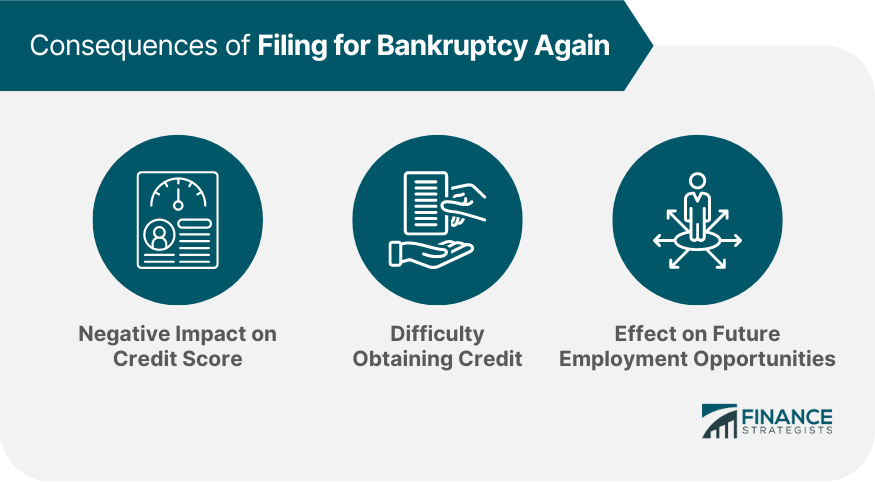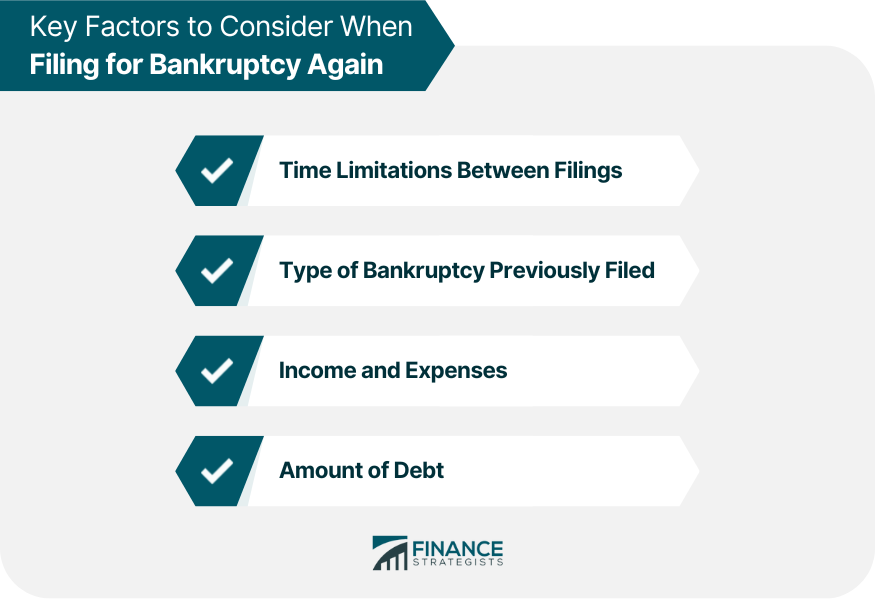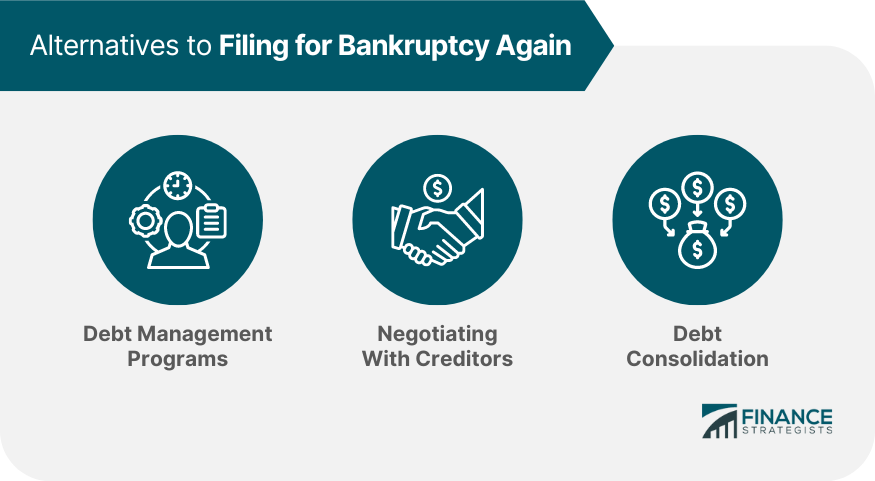Before considering filing for bankruptcy again, it is crucial to understand the eligibility requirements. The eligibility requirements depend on several factors, including time between filings, the type of bankruptcy previously filed, the amount of debt owed, income, and expenses. There are specific rules governing time limitations between bankruptcy filings. If an individual filed for Chapter 7 bankruptcy previously, they must wait eight years before filing again. In contrast, individuals who filed for Chapter 13 bankruptcy previously must wait two years before filing for Chapter 13 bankruptcy again. However, if they want to file for Chapter 7 bankruptcy, they must wait six years before doing so. The previous bankruptcy type filed affects a new filing. If someone previously filed for Chapter 7 bankruptcy, they may not be eligible to file again if they received a discharge. However, if they filed for Chapter 13 bankruptcy previously, they may be eligible to file for Chapter 7 bankruptcy if they paid off their debt or paid at least 70% of their unsecured debt during their repayment period. An individual's income and expenses also affect eligibility to file for bankruptcy again. For example, if their salary is below the median income in their state, they may be eligible to file for Chapter 7 bankruptcy again. However, if their income is above the state average, they may have to file for Chapter 13 bankruptcy and enter a repayment plan. The total amount of a person’s debt also influences their ability to file for bankruptcy for a second time. If the individual has too much debt, they may not be eligible to file for Chapter 13 bankruptcy. Furthermore, if it is the reverse and a person does not have enough debt, they may not qualify for bankruptcy relief at all. Suppose someone meets all requirements and is deemed eligible to file for bankruptcy again. The next step is determining which type is appropriate for their situation. The two most common types are Chapter 7 and Chapter 13 bankruptcy. It is a liquidation bankruptcy that eliminates most unsecured debt, such as medical bills, personal loans, and credit card debts. It is crucial to note that some types of debt, like student loans, taxes, and child support, are not dischargeable in bankruptcy. One of the main advantages of Chapter 7 bankruptcy is that it allows individuals to keep their exempt property, including items such as clothing, household goods, and personal property, among others. However, non-exempt property may be sold to repay creditors. Another advantage of Chapter 7 bankruptcy is that it is a relatively short process that usually lasts three to six months. Remember that bankruptcy can negatively impact an individual's credit score for up to ten years. Chapter 13 bankruptcy is a reorganization bankruptcy that allows individuals to repay their debts over three to five years. During this period, they must make payments to a bankruptcy trustee, who then distributes the funds to their creditors. One of the main advantages of Chapter 13 bankruptcy is that it allows individuals to keep their property, including their home and car. However, they must make timely payments to their creditors to avoid losing their assets. Another advantage of Chapter 13 bankruptcy is that it can stop a foreclosure or repossession and give individuals an opportunity to catch up on missed payments. Chapter 13 bankruptcy also allows individuals to discharge certain types of debt, such as credit card debt, medical bills, and personal loans, after they complete their repayment plan. However, Chapter 13 bankruptcy can last up to five years, which is longer than Chapter 7 bankruptcy. Additionally, missed payments can result in the dismissal of the bankruptcy case and the loss of protected assets. The choice between Chapter 7 and Chapter 13 bankruptcy depends on several factors, including the type of debt, the amount of debt, and the individual's financial circumstances. One of the main advantages of Chapter 7 bankruptcy is that it allows individuals to discharge most unsecured debt quickly. However, Chapter 13 bankruptcy may be the only option for individuals who do not qualify for Chapter 7 bankruptcy or who want to clear their non-dischargeable debt. Chapter 7 bankruptcy may be the better option for individuals with little to no property or assets, as they can discharge most of their debt and keep their exempt property. On the other hand, Chapter 13 bankruptcy may be a more suitable option for individuals with significant assets they wish to protect. Chapter 7 bankruptcy is a quicker process than Chapter 13 bankruptcy, but it does not allow individuals to repay their debts over time. Chapter 13 bankruptcy may be the better option for individuals who can afford to make regular payments but need more time to repay their debts. Filing for bankruptcy again can have several negative consequences. These consequences include a negative impact on the individual's credit score, difficulty obtaining credit, and potential effects on future employment opportunities. Filing for bankruptcy can significantly impact an individual's credit score. A bankruptcy filing can remain on a credit report for up to ten years, and it can lower the individual's credit score by 100-200 points or more. This negative impact can make it challenging to obtain credit in the future. After filing for bankruptcy, individuals may find it challenging to obtain new credit. Lenders may view them as high-risk borrowers, and they may be required to pay higher interest rates or provide collateral for a loan. Nevertheless, it is still possible to obtain credit after bankruptcy. Some lenders even specialize in working with individuals who have filed for bankruptcy. Filing for bankruptcy may also affect an individual's future employment opportunities. Some employers conduct credit checks as part of their hiring process. A bankruptcy filing may be considered a red flag by certain companies. If an individual is facing financial difficulties but does not qualify or does not want to file for bankruptcy, there are several alternatives to consider. It is a plan in which the individual makes regular payments to a credit counseling agency, which then distributes the funds to their creditors. This approach can help individuals consolidate their debt, reduce their interest rates, and make their debt more manageable. Individuals can also try negotiating with their creditors to work out a payment plan or reduce their debt. This approach can be effective, but it requires individuals to communicate effectively with their creditors and make timely payments. This alternative to filing for bankruptcy involves taking out a new loan to pay off existing debts. Debt consolidation can simplify payments and reduce interest rates, but it can also extend the repayment period and increase the total amount of interest paid. Filing for bankruptcy again is possible, but it depends on several factors, including eligibility requirements, type of bankruptcy previously filed, income, and expenses. If an individual is eligible to file again, they must determine which type of bankruptcy is appropriate for their situation. Both Chapter 7 and Chapter 13 bankruptcy have their advantages and disadvantages, and the choice between the two depends on factors like the discharge of debt, property retention, and the desired length of the repayment plan. Filing for bankruptcy again can have several negative consequences, including a decrease in an individual's credit score, difficulty obtaining credit, and potential impact on future employment opportunities. However, there are alternatives to consider, such as debt management programs, negotiating with creditors, and debt consolidation. Regardless of the approach taken, it is essential to seek professional advice before making any decisions. A bankruptcy attorney, credit counselor, or financial advisor can help individuals understand their options and make informed decisions about their finances. Taking proactive steps to manage debt can help individuals avoid financial difficulties in the future and achieve long-term monetary stability.
Can I File Bankruptcy Again?
Time Limitations Between Filings
Type of Bankruptcy Previously Filed
Income and Expenses
Amount of Debt

Types of Bankruptcy to File Again
Chapter 7 Bankruptcy
Chapter 13 Bankruptcy
How to Choose Between Each Type
Discharge of Debt
Property Retention
Length of Repayment Plan
Consequences of Filing for Bankruptcy Again
Negative Impact on Credit Score
Difficulty Obtaining Credit
Effect on Future Employment Opportunities

Alternatives to Filing for Bankruptcy Again
Debt Management Programs
Negotiating With Creditors
Debt Consolidation

The Bottom Line
Can I File Bankruptcy Again? FAQs
If you previously filed for Chapter 7 bankruptcy, you must wait eight years before filing again for Chapter 7 bankruptcy. However, after two years, you may be eligible to file for Chapter 13 bankruptcy.
Filing for bankruptcy again can significantly impact your credit score. A bankruptcy filing can remain on your credit report for up to ten years, and it can lower your credit score by 100-200 points or more.
The treatment of property depends on the type of bankruptcy you file. In Chapter 7 bankruptcy, non-exempt property may be sold to repay creditors. In Chapter 13 bankruptcy, you can keep your property, but you must make timely payments to your creditors to avoid losing your assets.
Yes, you may still be eligible to file for bankruptcy again. However, the eligibility requirements may differ depending on the reason for the dismissal.
There are several alternatives to consider, such as debt management programs, negotiating with creditors, and debt consolidation. Debt management programs involve regular payments to a credit counseling agency, which then distributes the funds to creditors. Negotiating with your creditors can help you work out a payment plan or reduce your debt. Debt consolidation involves taking out a new loan to pay off existing debts.
True Tamplin is a published author, public speaker, CEO of UpDigital, and founder of Finance Strategists.
True is a Certified Educator in Personal Finance (CEPF®), author of The Handy Financial Ratios Guide, a member of the Society for Advancing Business Editing and Writing, contributes to his financial education site, Finance Strategists, and has spoken to various financial communities such as the CFA Institute, as well as university students like his Alma mater, Biola University, where he received a bachelor of science in business and data analytics.
To learn more about True, visit his personal website or view his author profiles on Amazon, Nasdaq and Forbes.















